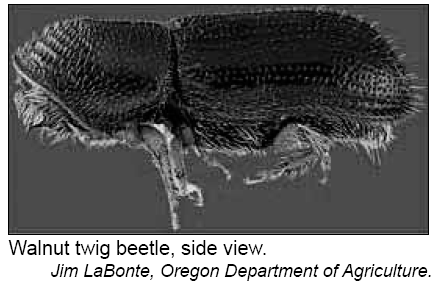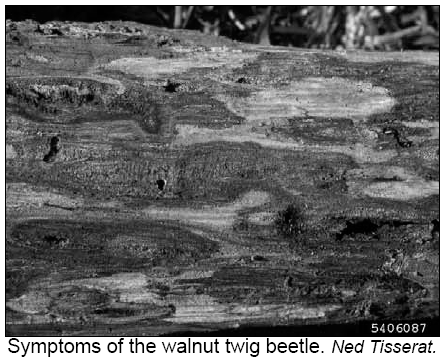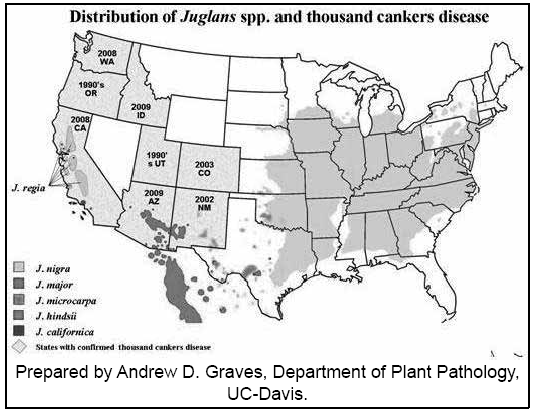Summer 2010
Volume 19 No. 2
Thousand Cankers Disease of Black Walnut – New Threat to an Important Tree to Forest Landowners and the Timber Industry
by Marcus McDonough and Phil Marshall

Thousand Cankers Disease is a recently discovered disease of Juglans species. It is a fungus (Geosmithia morbida) spread by the walnut twig beetle (Pityophthorus juglandis). The fungus infects the tree every time a beetle bores into a branch. The fungus creates cankers in the phloem and cambium robbing the tree of nutrients. The cankers grow together from each initial infection and eventually girdle branches.

These cankers are usually not visible unless the bark is peeled from infected areas. External symptoms, yellowing leaves, suddenly wilting leaves and branch dieback mark the end stage of this disease. Death of the tree occurs 2-3 years after leaf yellowing is first observed. Currently, Thousand Cankers Disease is only known to occur in the western United States (AZ, CA, CO, ID, NM, OR, UT, WA). There is major concern over the spread of Thousand Cankers Disease to the Eastern United States and it is the movement of infected walnut products by man that poses the greatest risk for spreading the disease to new areas.

One action state regulatory agencies are taking is the creation of an external quarantine that prevents and restricts the entrance and movement of Juglans sp. plants, logs, lumber, hardwood firewood and other products into the state from the western states. Three states have created an external quarantine for Thousand Canker Disease. Missouri Department of Agriculture established and announced their quarantine April 12, 2010. Nebraska Department of Agriculture established and announced their quarantine May 7, 2010. Michigan Department of Agriculture established and announced their quarantine May 27, 2010. Following these quarantines, the Indiana Department of Natural Resources, Division of Entomology and Plant Pathology is considering a similar quarantine to help protect valuable black walnut resource in Indiana’s forests and plantations. The U.S. Forest Service, along with state natural resource and agricultural agencies and university researchers are currently working to develop a national response plan for this disease. For more information on the disease go to www.thousandcankerdisease.com/. To view the quarantines, visit the website for each state:
-
Missouri - mda.mo.gov/plants/pests/thousandcankers.php
-
Michigan - www.michigan.gov/mda
Marcus McDonough is a nursery inspector and compliance officer for the IDNR Division of Entomology and Plant Pathology. Phil Marshall is director of the IDNR Division of Entomology and Plant Pathology.
